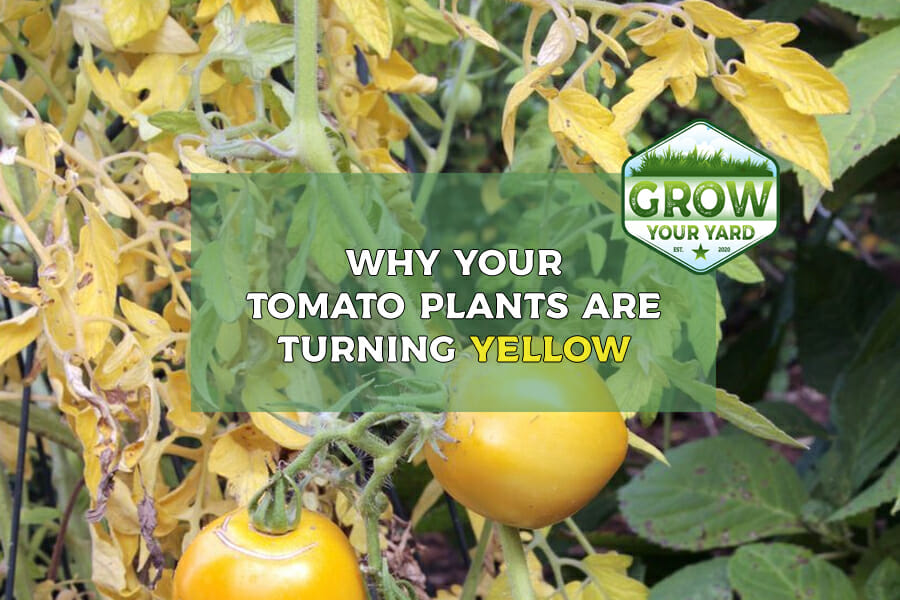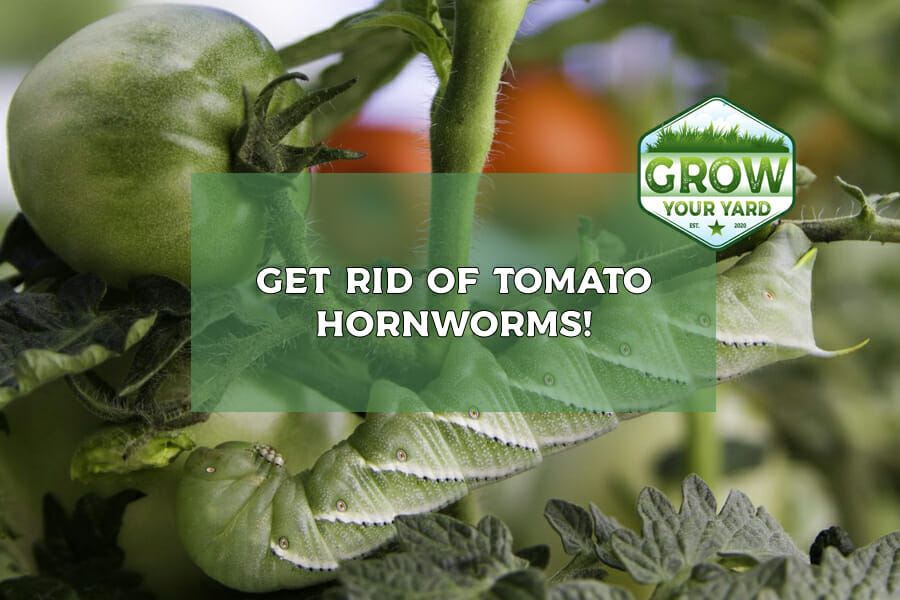
Tomatoes are one of the most popular vegetables, a great source of essential vitamins. If you’re reading this, then it’s probably because you’re wondering why the leaves on your tomatoes are turning yellow since tomatoes are typically green and vibrant.
There are several reasons why the leaves on tomato plants turn yellow. The most common reason is water stress, either overwatering or underwatering. Yellowing can also result from Nitrogen deficiency, inadequate sunlight, pests, and diseases.
In this article, you’ll find in-depth explanations for all the causes of tomato plant yellowing mentioned above and the possible solutions to get you tomato plant back on track.
What causes tomato plants to turn yellow?
Chlorosis or yellowing is a condition where plant leaves turn yellow due to insufficient chlorophyll, the compound responsible for the green pigment in plants.
There are several reasons why your tomato plant is turning yellow, such as:
- Underwatering
- Root rot
- Nutrient deficiencies
- Inadequate sunlight
- Pests
- Fungal and viral diseases
Underwatering
When your tomato gets too little water, the leaves, especially those near the base, start to yellow and eventually drop. The yellowing and eventual leaf drop is your tomato’s way of conserving water by reducing the number of leaves on it.
The Cure
You can easily correct the effects of underwatering by giving your plant more water, but try not to overdo it, as too much water can cause more problems.
Root Rot
Root rot is a disease that affects plant roots growing in constantly damp or wet soil. Prolonged wetness cuts off oxygen supply, causing the roots to die and rotten. The rot spreads from dead roots to nearby roots, eventually compromising the entire root system and affecting the plant’s ability to absorb water and nutrients.
Since the plant can no longer absorb water and nutrients (like Nitrogen), it begins to wilt, turn yellow, and experiences stunted growth.
The leading causes of root rot are:
- Overwatering
- Soil fungus
- Poor soil drainage
- Unsuitable planters
Overwatering and Soil Fungus
New gardeners, especially, believe that plants can’t have too much water. While water is essential for a healthy plant, too much of it can cause problems. The excess water in the soil blocks out oxygen, causing rot to set in.
Soil fungus such as Fusarium, Phyton, Phytophthora, and Rhizoctonia can also cause root rot, as tomato plants are particularly prone to fungal attack. These fungi can remain dormant in the soil with no adverse effect on the plant, but one or two instances of overwatering can reactivate the pathogens, which will, in turn, attack the roots.
Poor Soil Drainage
Poorly drained and heavily compacted soils (like clay) retain water for extended periods. As such, the roots of your tomato will eventually start rotting from the wetness.
Unsuitable Planters
This one only affects plants growing in containers. Even with proper watering and well-drained soil, rot can still arise when the pot/container doesn’t allow water to flow out, leading to soggy soil.
The Cure To Root Rot
There’s no sure way to diagnose root rot, as the roots are buried away from sight. If you suspect root rot, you’ll need to remove the plant from the soil and inspect the roots.
Gently hose down the soil trapped in the root system to reveal the color and nature of individual roots. Healthy tomato roots are white and firm to the touch, whereas decayed roots will be brown/black, feel mushy, and may fall off when touched.
If the rot is minimal, you can use clean shears or a knife to cut off the affected roots and then transfer the plant to a new container with well-drained soil.
However, in severe cases where up to half of the roots are rotten, merely cutting off bad roots will not work, as the already weakened plant may not survive on half of a root system. In such cases, it’s best to discard the soil and the plant.
Ensure that you don’t use the discarded plant for composting, as this may spread the root rot fungus to new plants, the same way the old soil will too.
Preventing root rot
“Prevention is better than cure,” remember the saying? Well, it applies literally to root rot, as the disease is not easily detected. Symptoms typically start showing at the advanced stages of the disease, at which point it’s too late to salvage the plant. As such, you should take steps to prevent rather than cure the disease.
Some root rot prevention measures include:
- Proper watering
- Planting in well-drained soils like a mix of equal potting soil, perlite, compost, and peat moss
- Ensure that water can leave the soil.
- Never grow new tomatoes in soil that’s had rotten roots before
Nitrogen Deficiency
Nitrogen is an essential nutrient for proper plant growth, and so leaves turn yellow and become stunted when there’s not enough of it in the soil. Yellowing from lack of Nitrogen usually starts from the bottom leaves then moves to the younger leaves at the top.
The Cure
The cure to Nitrogen deficiency is, of course, to increase the Nitrogen in the soil. But before pumping fertilizer into the soil, it’s ideal that you perform a soil test to determine the level of deficiency.
A balanced 10-10-10 liquid fertilizer will work for slight deficiencies. You can use a fertilizer with more Nitrogen if the deficiency is severe, but ensure that you don’t use more than the recommended amount, as too much Nitrogen will encourage leaf growth over fruit production, leading to a lush plant with few fruits. It’s also important that you water the plant before you apply fertilizer to prevent root burn.
Inadequate Sunlight
Similar to underwatering, the bottom leaves on the tomato will turn yellow when there’s not enough light reaching them. Unlike underwatering, however, such yellowing isn’t lethal, as it mostly affects bigger and mature plants, where top leaves and fruits block out sunlight from the bottom of the plant.
The Cure
As stated, bottom leaves that turn yellow from inadequate sunlight aren’t much of a problem, except an aesthetical one. If you do not like how they look, you can use a clean knife or shears to cut them off.
Pests
Several insect pests can attack tomatoes and cause the plant to go yellow. Some of these insects include aphids, thrips, whiteflies, and mealybugs.
Thrips are tiny winged insects that appear in a range of colors from yellow to black. They spread viruses like the tomato spotted wilt virus (TSWV), causing bronzing leaves, among other symptoms.
Whiteflies are small, white, winged insects that suck sap from the underside of tomato leaves, leading to stunted growth and yellowing. Whiteflies also transmit the Tomato Yellow Leaf Curl Virus (TYLCV), which, as the name suggests, causes leaves to curl and yellow.
Aphids and Mealybugs are small wingless sap-sucking insects. Too many of either insect draining your tomato will stunt its growth and yellow the leaves.
The Cure
You can use insecticidal soaps or neem oil to get rid of insect pests.
Beneficial insects like ladybugs and lacewings feed on aphids and mealybugs; you can introduce them to your garden as biological pest control.
Fungal Diseases
Tomatoes are prone to a number of fungal diseases, and some of them can cause yellow leaves. The most common yellowing diseases include:
- Early blight
- Septoria leaf spot
- Fusarium wilt
Early blight is caused by Alternaria tomatophila and Solani. The disease manifests as yellow leaves with small spots that grow into a bull’s eye pattern.
The Septoria lycopersici fungus causes Septoria Leaf Spot. It usually affects the lower leaves of tomatoes as the plant begins to bear fruit, causing numerous spots to appear on older leaves. Leaves affected by the disease turn yellow.
Fusarium wilt occurs mainly during the warm season, causing the leaves on one side to turn yellow. It also stunts the growth of the plant and prevents it from fruiting.
The Cure
You can use Mancozeb or Chlorothalonil fungicides to treat early blight, fusarium wilt, and Septoria leaf spot.
Viral Diseases
There are a couple of viruses you can blame for the yellowing leaves on your tomatoes, such as mosaic virus, cucumber virus, yellow leaf curl virus, and tobacco mosaic virus. The viruses are transmitted by insects like whiteflies, thrips, and aphids. Gardeners may also unknowingly spread viruses with unclean hands and tools.
You can generally identify viruses by the mosaic pattern on the leaves and retarded growth. Some, like the yellow leaf curl virus, might also affect the shape of the leaves as well.
The Cure
Sadly, there are no cures or chemical control yet for these viruses, so you’ll have to discard any affected plants immediately to stop the disease from spreading. Ensure that you wash your hands and tools properly to avoid unwittingly transmitting the virus to other plants.
Also, eliminate weeds and virus-carrying insects like thrips and whiteflies from within and around your garden.
Final Thoughts
Both underwatering and overwatering can cause problems for your tomato plant. But if at all, it’s better to underwater than overwater, as it’s easier to correct the effects of underwatering. With overwatering, the leaves only start turning yellow when the roots have been extensively damaged, at which point it may be too late to correct.
So it’s important that you water the plant correctly. But this is easier said than done, as there is no perfect watering schedule that works in all cases. If you live in a hotter climate, you’ll need to give your tomato more water to compensate for the moisture lost to evaporation and transpiration. Conversely, tomatoes in humid areas need less water as there’s moisture present in the air.
An effective way to water your tomato plant, despite the local climate, is to push your index finger into the soil and only water the plant if the finger comes out dry, by pouring just enough water to make the soil moist but not soggy. This method ensures that you never overwater the plant.


